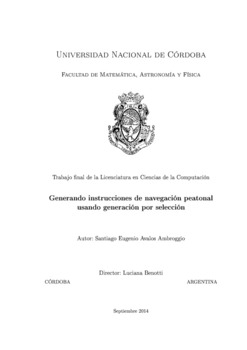| dc.contributor.advisor | Benotti, Luciana | |
| dc.contributor.author | Avalos Ambroggio, Santiago Eugenio | |
| dc.date.accessioned | 2020-08-13T16:59:59Z | |
| dc.date.available | 2020-08-13T16:59:59Z | |
| dc.date.issued | 2014-09 | |
| dc.identifier.uri | http://hdl.handle.net/11086/15891 | |
| dc.description | Tesis (Lic. en Ciencias de la Computación)--Universidad Nacional de Córdoba, Facultad de Matemática, Astronomía y Física, 2014. | es |
| dc.description.abstract | En este trabajo describimos un método para desarrollar un instructor virtual de navegación peatonal basado en interacciones reales entre humanos. Un instructor virtual es un agente capaz de cumplir el rol de un instructor humano, y su objetivo es asistir a un usuario humano a llevar a cabo diferentes tareas dentro del contexto de una ciudad real. Para poder cumplir con su trabajo, un instructor virtual necesita poseer la capacidad de describir lo que necesita hacerse de una manera efectiva, considerando las características del entorno virtual en el cual se encuentra, y logrando comprometer al usuario en la tarea propuesta. El instructor presentado se comunica utilizando un algoritmo de generación por selección, basado en un corpus de interacciones reales anotado previamente de forma automática, generado dentro del mundo de interés. Este sistema es resistente a errores de interpretación por parte del usuario, está al tanto de la ubicación del usuario constantemente, y usa diferentes puntos de referencia de la ciudad para guiarlo. El instructor fue evaluado con usuarios reales de forma situada en Street View de Google en la ciudad de Edimburgo en la plataforma provista por la competencia internacional GRUVE. El instructor generado fue superior al baseline provisto por la competencia en diversas métricas, como naturalidad y efectividad de las instrucciones, entre otras. | es |
| dc.description.abstract | In this work we describe a method to develop a virtual instructor for pedestrian navigation based on real interactions between a human instructor and a human pedestrian. A virtual instructor is an agent capable of fulfilling the role of a human instructor,and its goal is to assist a pedestrian in the accomplishment of different tasks within the context of a real city. In order to guide a user while performing a task, an effective instructor knows how to describe what needs to be done in a way that accounts for the nuances of the virtual environment and that is good enough to engage the trainee or the gamer in the activity. The instructor decides what to say using a generation by selection algorithm, based on a automatically annotated corpus of real interactions generated within the world of interest, and is able to react to different requests by the pedestrian. The instructor can deal with interpretation errors made by the user, is constantly aware of the pedestrian position, and it can use different city landmarks to guide him. The instructor was evaluated with real users through Google Street View, located in the city of Edinburgh, by means of the platform provided by the international challenge GRUVE. The generated instructor was superior to the baseline system provided by this challenge in various metrics, such as naturalness and effectiveness of instructions, among others. | en |
| dc.language.iso | spa | es |
| dc.rights | Attribution-NonCommercial-NoDerivatives 4.0 International (CC BY-NC-ND 4.0) | * |
| dc.rights.uri | http://creativecommons.org/licenses/by-nc-nd/4.0 | * |
| dc.subject | Instructores virtuales | es |
| dc.subject | Generacion de lenguaje natural | es |
| dc.subject | Generación de instrucciones | es |
| dc.subject | Navegadores peatonales | es |
| dc.subject | Aprendizaje automático | es |
| dc.subject | Landmarks | en |
| dc.title | Generando instrucciones de navegación peatonal usando generación por selección | es |
| dc.type | bachelorThesis | es |
| dc.description.fil | Fil: Avalos Ambroggio, Santiago Eugenio. Universidad Nacional de Córdoba. Facultad de Matemática, Astronomía, Física; Argentina. | es |
| dc.journal.referato | | |





